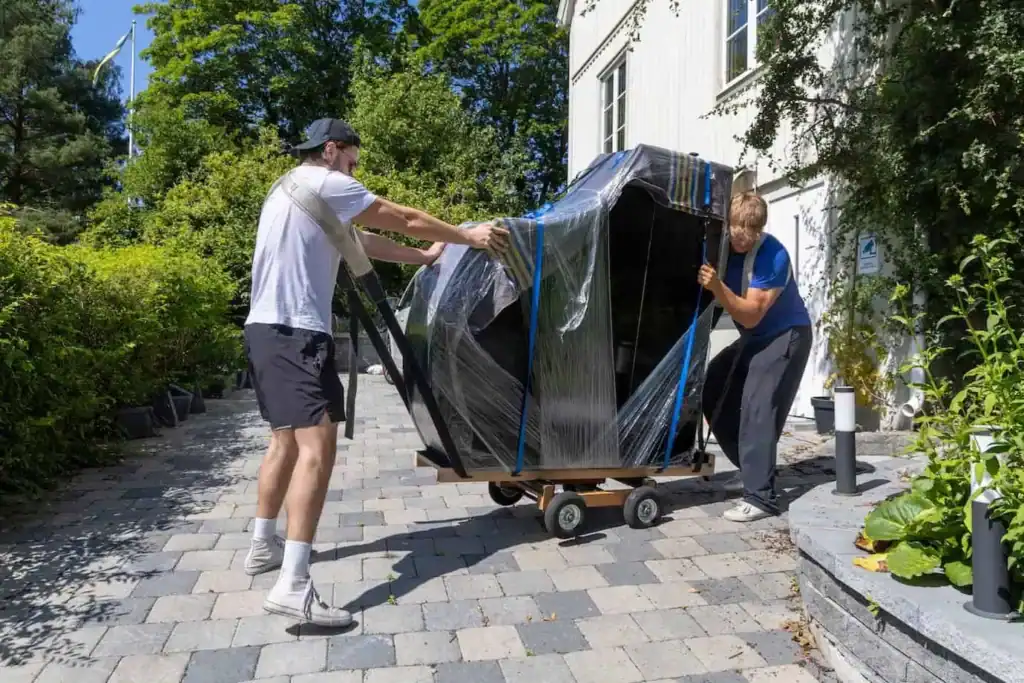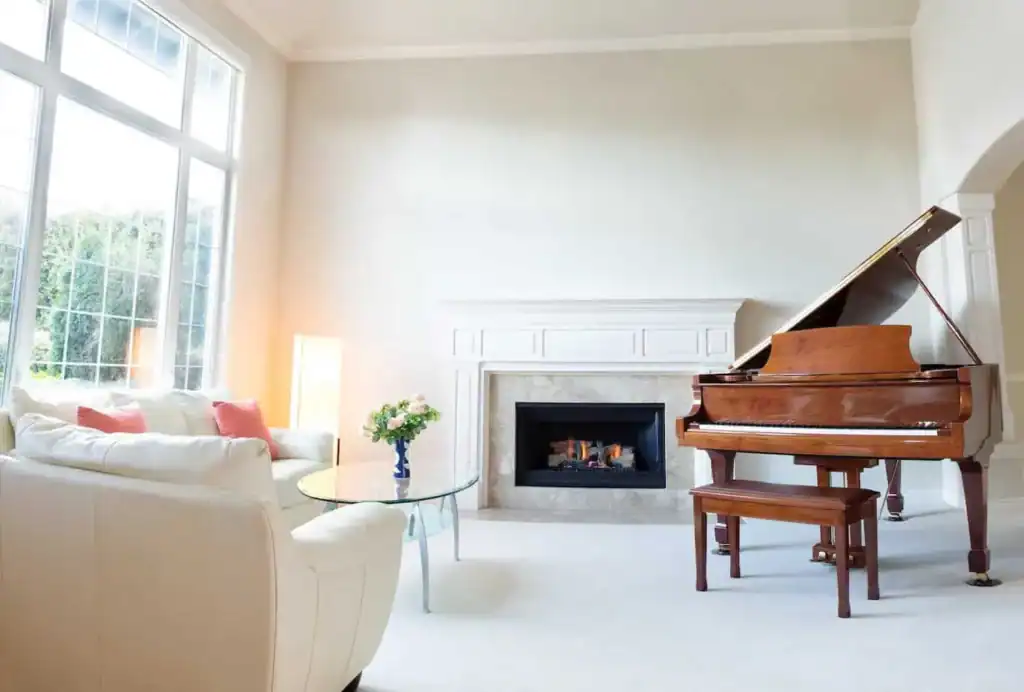Moving boxes and furniture is one thing, but moving a piano is a whole different ball game. So, how much exactly does it cost to move a piano? The typical cost is $330–$2,155 or more, but the exact price will depend on various factors, including the piano’s size and how far you’re moving.
How much pianos weigh also has a lot to do with the high cost of moving them. Ranging from 200–1,200+ lbs, they’re heavy, awkward, and delicate instruments that require special expertise to move without causing damage or injury. In fact, the risk of damage to the instrument and personal injury to the movers is so great that some companies won’t even touch a piano. And those who will often charge a special fee for the service.
In this article, we’ll discuss the factors that go into piano moving costs, the average cost to move a piano, and how to find movers who know how to move a piano the right way.
Average Cost To Move a Piano
We obtained moving quotes from multiple companies for each type of piano and a variety of distances — from just around the corner to across the country.
Keep in mind these quotes assume a simple move — street level, with no stairs or tight corners.
Average Cost To Move a Piano by Type and Distance
| Piano Type | Weight | Local Move | Long-Distance Move |
| Upright Piano | 500-800 lbs. | $330 | $1,870 |
| Baby Grand Piano | 500-600 lbs. | $420 | $2,050 |
| Grand Piano | 600-700 lbs. | $525 | $2,155 |
Why Get Multiple Quotes?
In our research, we found that one of the companies we reached out to was significantly more expensive than the rest, so we left their quotes out of our average cost calculations. Depending on the distance of the move, the quotes were between three and eight times higher than those from the other companies. This just goes to show the importance of getting multiple quotes for moving services.
Factors That Affect Piano Moving Costs
There are several factors that affect piano moving costs and understanding these can help you know what to ask when getting a quote and understand pricing better.
Style, Size, and Weight
When it comes to moving a piano, the style, size, and weight are major factors that affect the cost. The lighter your piano is and the easier it is to maneuver, the less it will cost. The heavier and more difficult it is to move, the more it will cost.
“No matter how strong you are or how many willing friends you have, it’s never a good idea to DIY a piano move…The added risk of bodily harm, property damage, and instrument damage just isn’t worth it.”
The cheapest style to move is an upright, followed by a baby grand, and finally a grand piano. Within each category, there are size and weight differences depending on the model, so keep that in mind.
Accessibility
If movers have to navigate up or down stairs, via elevators, or around multiple tight corners, it’ll take longer to move the piano, and additional movers may be required. In either scenario, the cost to move your piano will increase.
Special Handling
Grand pianos that are especially large or valuable may need to be transported in a climate-controlled truck or even crated during the move. These special services offer greater protection for the instrument during transit, but they also cost more than a standard piano move.
Number of Movers and Labor Hours

Upright pianos can typically be handled by just two or three movers, but larger pianos (like baby grands and grands) may require four or five. Many moving companies charge an hourly rate based on the number of movers and the time required. They base their estimate of manpower, time, and rate on the size and weight of the piano and how accessible it is — for instance, an upright piano located on the ground floor is easiest.
Piano Tuning
While this isn’t something movers would do, it is another cost to consider when planning to move your piano, since even moving just a short distance across town will put your piano out of tune. Tuning a piano usually costs between $100 and $200, but it could cost more depending on the piano itself and your location. After your move, wait a few weeks before calling the tuner to allow the instrument to acclimate to its new environment.
Local vs. Long-Distance Piano Moves
How much does it cost to move a piano locally vs. long-distance? A local piano move will typically cost between $330 and $525, while a long-distance piano move will cost between $1,870 and $2,155 (or more).
Wondering why long-distance is so much pricier? The following cost breakdowns show what moving companies have to consider when charging for a local vs. long-distance piano move.
Local Move Cost Breakdown
The cost of moving a piano locally generally depends on the following:
- Hourly or flat rate based on the size and weight of the piano
- Fees related to accessibility
- Special handling
- Taxes
Some local moving companies also charge additional fees, such as:
- Truck and travel fees to cover the cost of the truck and the drive to and from the job
- Administrative fee
- Packing supplies (beyond the typical essentials like dollies, straps, and padding/blankets), which may include cardboard, shrink wrap, crating, or extra padding if requested by the customer
Long-Distance Move Cost Breakdown
The cost of moving a piano long-distance (typically defined as a move greater than 50 miles) usually depends on the following factors:
- Flat rate based on the size, style, and weight of the piano, as well as accessibility and other factors
- Fees related to accessibility
- Special handling
- Mileage
- Fuel surcharge
- Supplies (such as cardboard, padding, shrink wrap, or crating if required)
- Taxes
Storage Fees
If you need to store your piano during or after your move, some companies offer climate-controlled piano storage for a monthly fee. The cost to move a piano into storage is generally the same as a local piano move. After that, you pay a monthly rate for as long as it’s stored. We got a quote for monthly piano storage, and it came to $100 for either an upright or baby grand and $150 for a grand piano.
Should You Hire Specialty Piano Movers or General Movers?
Hiring general movers without experience moving pianos could spell disaster for your instrument. One wrong move and you could find yourself with a broken pedal, a gaping hole in your wall, or worse — an injured mover.
While there are movers whose entire business revolves around moving pianos, there are also companies that specialize in both general moving and piano moving. Either option will work, just be sure to avoid movers who don’t have prior experience.
How To Save Money on Piano Moving

There’s no way around how expensive moving a piano is, but you can soften the blow. Here are our three top tips for how to save money when moving a piano.
Move During Unpopular Times
Moving companies charge higher rates over the weekends and during the summer. You can save some money by scheduling your move Monday through Thursday, and even more if you can wait for the colder months.
Be Flexible with Your Move Date
If you’re not in a rush to move your piano, you can ask the moving company to combine your move with another going in the same direction. Since they’re already going that way, some moving companies will offer you a significant discount for the chance to kill two birds with one stone.
Compare Moving Quotes
While the cost to move a piano will vary from one company to the next, we found most of the quotes we got were pretty similar. However, one company we looked at quoted thousands of dollars more for long-distance piano moves. This is why comparing quotes is so important. Not only does it help you find an affordable mover, it also gives you a good idea of the going rate in your area (so you can spot price gouging when you see it).
“Tuning a piano usually costs between $100 and $200, but it could cost more depending on the piano itself and your location. After your move, wait a few weeks before calling the tuner to allow the instrument to acclimate to its new environment.”
You can call moving companies or request quotes online, but — based on our experience researching this guide — it’s not easy. Some companies don’t offer quotes over the phone, and others require quote requests via email. If that doesn’t sound like something you’d enjoy, you can use HireAHelper.com instead. With over 1,700 vetted movers nationwide and more than 1,000,000 moves completed, HireAHelper makes it easy to compare piano movers in your area.
Hire One Company That Does It All
If you’re moving your entire household (and not just your piano), you can save on moving costs by combining the two services. Before hiring a moving company, make sure they offer piano moving services (or have experience with moving pianos) and ask them what it would cost. It’ll almost certainly be cheaper than hiring single-item movers to move the piano separately.
Why You Shouldn’t DIY a Piano Move
No matter how strong you are or how many willing friends you have, it’s never a good idea to DIY a piano move. Pianos are extremely heavy and awkward. The added risk of bodily harm, property damage, and instrument damage just isn’t worth it.
Not only do professional movers know how to secure and move each type of piano to minimize the risk of damage and injury, but they also have insurance just in case. If something goes wrong during a DIY piano move, the expense will fall on you, and it will almost certainly be higher than the cost to move a piano professionally.

